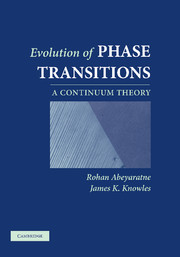Crossref Citations
This Book has been
cited by the following publications. This list is generated based on data provided by Crossref.
Irschik, H.
2007.
On rational treatments of the general laws of balance and jump, with emphasis on configurational formulations.
Acta Mechanica,
Vol. 194,
Issue. 1-4,
p.
11.
Berezovski, Arkadi
and
Maugin, Gérard A.
2007.
Moving singularities in thermoelastic solids.
International Journal of Fracture,
Vol. 147,
Issue. 1-4,
p.
191.
KNOWLES, JAMES K.
2007.
DRIVING FORCE AND KINETIC RELATIONS FOR SCALAR CONSERVATION LAWS.
Journal of Hyperbolic Differential Equations,
Vol. 04,
Issue. 01,
p.
19.
Dondl, Patrick W.
and
Bhattacharya, Kaushik
2007.
The effect of precipitates on the evolution of a martensitic phase boundary.
PAMM,
Vol. 7,
Issue. 1,
p.
1151207.
Glüge, R.
and
Kalisch, J.
2008.
Micro-Macro-interaction.
p.
93.
Knowles, James K.
2008.
On the structure of the Hugoniot relation for a shock-induced martensitic phase transition.
Shock Waves,
Vol. 17,
Issue. 6,
p.
421.
Knowles, J.K.
2008.
On entropy conditions and traffic flow models.
ZAMM - Journal of Applied Mathematics and Mechanics / Zeitschrift für Angewandte Mathematik und Mechanik,
Vol. 88,
Issue. 1,
p.
64.
Berezovski, Arkadi
and
Maugin, Gérard A.
2008.
Defect and Material Mechanics.
p.
191.
Eremeyev, Victor A.
and
Pietraszkiewicz, Wojciech
2009.
On the bending and tension of thermoelastic shells undergoing phase transitions.
PAMM,
Vol. 9,
Issue. 1,
p.
305.
Collet, Manuel
Ouisse, Morvan
Foltête, Emmanuel
and
Lexcellent, Christian
2009.
Isothermal and anisothermal implementations of 2D shape memory alloy modeling for transient impact response calculation.
Smart Materials and Structures,
Vol. 18,
Issue. 12,
p.
125019.
Eremeyev, Victor A.
and
Altenbach, Holm
2009.
IUTAM Symposium on Progress in the Theory and Numerics of Configurational Mechanics.
Vol. 17,
Issue. ,
p.
121.
Maugin, Gerard A.
and
Berezovski, Arkadi
2009.
On the Propagation of Singular Surfaces in Thermoelasticity.
Journal of Thermal Stresses,
Vol. 32,
Issue. 6-7,
p.
557.
Baek, Seungik
and
Pence, Thomas J.
2010.
Emergence and disappearance of load induced fiber kinking surfaces in transversely isotropic hyperelastic materials.
Zeitschrift für angewandte Mathematik und Physik,
Vol. 61,
Issue. 4,
p.
745.
Knowles, James K.
2010.
On Maximally Dissipative Shock Waves in Nonlinear Elasticity.
Journal of Elasticity,
Vol. 98,
Issue. 1,
p.
13.
Shaw, John A.
Churchill, Christopher B.
Lagoudas, Dimitris C.
and
Kumar, Parikshith
2010.
Encyclopedia of Aerospace Engineering.
Truskinovsky, Lev
and
Vainchtein, Anna
2010.
Beyond kinetic relations.
Continuum Mechanics and Thermodynamics,
Vol. 22,
Issue. 6-8,
p.
485.
Glüge, R.
Bertram, A.
Böhlke, T.
and
Specht, E.
2010.
A pseudoelastic model for mechanical twinning on the microscale.
ZAMM - Journal of Applied Mathematics and Mechanics / Zeitschrift für Angewandte Mathematik und Mechanik,
Vol. 90,
Issue. 7-8,
p.
565.
Raj, Ritwik
and
Purohit, Prashant K.
2010.
Moving interfaces in rod-like macromolecules.
EPL (Europhysics Letters),
Vol. 91,
Issue. 2,
p.
28003.
Berezovski, A.
and
Maugin, G.A.
2010.
Jump conditions and kinetic relations at moving discontinuities.
ZAMM - Journal of Applied Mathematics and Mechanics / Zeitschrift für Angewandte Mathematik und Mechanik,
Vol. 90,
Issue. 7-8,
p.
537.
Qiao, Lei
Rimoli, Julian J.
Chen, Ying
Schuh, Christopher A.
and
Radovitzky, Raul
2011.
Nonlocal Superelastic Model of Size-Dependent Hardening and Dissipation in Single Crystal Cu-Al-Ni Shape Memory Alloys.
Physical Review Letters,
Vol. 106,
Issue. 8,





